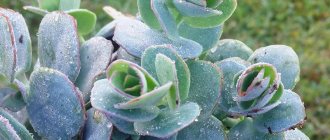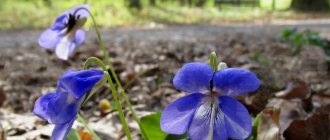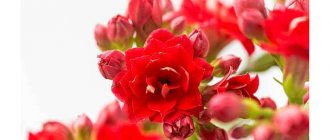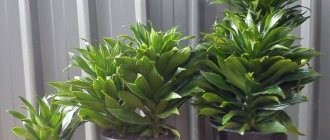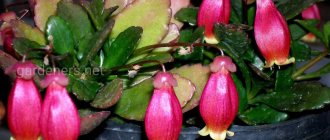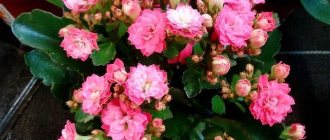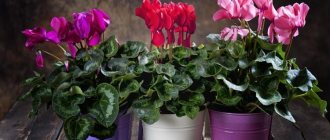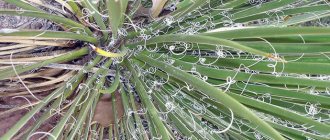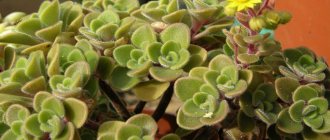Kalanchoe is a fairly common houseplant. There are various types of it: succulent plants, herbaceous perennials, subshrubs. Today, there are about 200 species of Kalanchoe around the world. This genus belongs to the Crassulaceae family. In nature, it can be found in Asia, Australia and America. We usually grow it at home. Let's learn in detail about how to organize proper care at home for Kalanchoe Mix and its various varieties.
Short description
You may be interested in: Growing bamboo in water at home, care, reproduction, diseases
Types of Kalanchoe do not differ too much from each other in appearance and care. The main difference lies in the shape of the leaves, which, depending on the variety, can be thick, dissected, sessile, or located on the petiole. In this article we look at varieties of Kalanchoe Mix, home care and cultivation features.
As already mentioned, Kalanchoe Mix has several subspecies that differ in external characteristics. The most common is Mini Mix, or Blossfeld variety. This is a fairly compact plant that fits perfectly on a windowsill. It is distinguished by a lush flowering crown. Flowers have a variety of shades: red, white, lilac, pink. It is also worth noting Kalanchoe Kalandiva mix; caring for it at home is very simple, so many choose this particular variety not only because of its ease of cultivation, but also for its fascinating flowering. Kalandiva has large fleshy velvety leaves, a rather thick stem and small double flowers that form lush red, pink or yellow blooms. It is impossible not to mention Kalanchoe Rosalina mix; caring for this species at home also does not cause much trouble. From the name itself it is clear that Rosalina has pink flowers and is also famous for its healing properties.
Varieties and their photos
Mix
A hybrid variety developed from Kalandiva, resembling the shape of a bush. It reaches a maximum height of 30 cm.
Large, rounded leaves form a cup from which a fluffy flower stalk emerges from a short stem, ranging from red to creamy white. Particularly valued for its ability to bloom all year round.
Double Mix
A more compact version of Kalanchoe Mix. The leaves are not large, thick but fragile, densely dotted on the trunk. The advantage of the variety is its lush flowering . Bright small flowers with scaly leaves. Flowering period lasting a month at the end of winter.
Mini Mix
A dwarf variety, with double, fleshy inflorescences of all colors of the rainbow. Reaches no more than 20 cm in height.
Lighting
You may be interested in: Coin tree: care and maintenance at home, medicinal properties
If you grow Kalanchoe at home, then first of all you should pay attention to lighting. For this flower, daylight hours must last at least twelve hours. That is why, from spring to autumn, the pot with the plant should be placed on a window that faces the east or west side. In winter, it is better to move it to the south side. If you live in a region where daylight hours in winter are too short, you will need to take care of artificial lighting.
Possible problems
In the process of breeding Kalanchoe, flower growers may encounter one or another problem. In each case, you need to know the algorithms for solving them and act in accordance with them.
Doesn't bloom
If the Kalanchoe did not bloom this season, it is necessary to determine the reason for this and eliminate it.
Lack of flowering can be observed in the following cases:
- Excess fertilizer, which makes the soil too heavy.
- Excessive lighting. Direct sunlight burns the plant, preventing the formation of a flower bud. Very long daylight hours slow down the formation of buds.
- Lack of lighting. If the plant sits in the shade for too long, the stem lengthens, which also prevents flowering.
- Lack of a resting phase after the flowering period.
- Lack or excess of moisture. Alternating periods of drought with periods of waterlogging causes great harm.
Leaves wither and turn yellow
Wilting, yellowing and dropping leaves may indicate a lack of nutrients, poor soil or too little light. Often, such signs are symptoms of a bush being infected with flower aphids.
Diseases and pests
Kalanchoe is hardy and rarely gets sick. If this does happen, then we can talk about deficiencies in care and nutrition, which led to a decrease in immunity.
Mold
Mold on the leaves indicates too frequent watering and spraying, or keeping the plant in a cold, damp room.
Powdery mildew
The reason for the appearance of a white coating on the stem and leaves (powdery mildew) is keeping it in a room that is too warm. The plant develops slowly and gradually fades. Treatment consists of treatment with fungicides (Topaz, Chistotsvet).
Aphid
Flower aphids damage foliage and shoots. Symptoms are yellowing, falling leaves, and a sticky coating on them. The drugs Actellik and Commander are used for treatment. Treatment with tobacco dust helps.
Mealybugs
Infection of a plant with mealybugs manifests itself in the appearance of oily, waxy secretions on the leaves, which leads to gradual wilting. The treatment is:
- the affected parts of the plant are removed;
- in severe stages, insecticides or spraying with mineral oils M-30, M-50 are used.
Temperature
You may be interested in:Venus flytrap: how to care for the plant at home
Kalanchoe is not one of the capricious plants and feels absolutely normal at any temperature in the room. But this does not mean that you can put it on the balcony in winter. In summer, the air temperature in the room should not fall below 18 degrees and rise above +28 °C. In winter, the flower can easily tolerate a drop in temperature to +14 °C. It is worth considering that if the air temperature in the room is below ten degrees with a plus sign, then there is a high probability that the plant will become very sick, and perhaps even die. Also note that at low temperatures, buds begin to appear on the plant.
Conditions of detention
When caring for Kalanchoe in the proposed home conditions, watering is important, but not excessive, otherwise the roots may begin to rot. Water the crop often and little by little, especially during flowering. In the spring and summer, you need to use settled, cool water. Do not allow moisture to get on the surface of the foliage and stem. Optimally, a flower of the Mix species is watered once every 3 days. An excess of moisture is more dangerous for him than a lack of it. The remaining water must be drained from the pan. If it stagnates plus low temperature, the plant can die. It is better to water as the top layer of soil dries. In winter, so that the culture does not experience stress, warm water is used.
When growing this beauty at home, take into account his love for the sun. After lunch, it should be removed from the sun and create a little twilight. It is better to do without moving and simply cover the plant with a light cloth. This way your pet will not get burnt to the stem and leaves. In winter, it is possible to grow the crop in one place. To care for this exotic at home, set the room temperature within 16 - 20 degrees Celsius. If it temporarily drops lower, it will not harm the plant. Indoor culture only does not tolerate heat well - it consumes a lot of liquid and begins to get sick.
The plant does not require high levels of humidity. This is true for both air and soil in the pot. Since the stem quickly absorbs moisture, the result is fungal diseases and mold. In winter, the flower generally needs minimal air humidity in the room.
This plant can do without fertilizing. But if there is a deficiency of the mineral, use cacti fertilizer. You can't bring it in in winter. Even with slight wilting in winter, you should wait until late spring to fertilize. Liquid fertilizers are required; before application, they are dissolved in warm water. This way the root system will receive adequate nutrition.
Caring for the crop is not difficult if you follow all of the above and replant the flower on time. Transplantation is carried out frequently, it cannot be done during the flowering period, it is better to plan for the end of spring. It is done by transferring a clod of earth into a new pot. Adaptation after transplantation occurs within a week. Don't forget to add fertilizer. The properties and composition of the new soil should be identical to the old one.
Caring for exotic plants at home involves shaping and pruning. This is done to give the plant a beautiful shape. Each variety perceives the procedure differently. For example, Blossfeld can be trimmed without restrictions. When pruning, the peduncle, overly long stems and damaged parts of the crop are cut lower. Young stems are cut off to further obtain roots. It is unacceptable to prune and shape the pet during flowering.
How to water Kalanchoe Mix
Kalanchoe Mix at home should be watered only with soft, settled water at room temperature. There is no need to overwater the plant, as rotting may begin. It is recommended to moisten the soil only when the top layer is completely dry. Moreover, Kalanchoe is a crassula plant, which means that its fleshy leaves always contain a small supply of water. But at the same time, the situation cannot be brought to the point where the earthen ball dries out completely. This situation often leads to the leaves starting to fall off the plant. In winter, the watering technology is that the substrate is moistened three or four days after it dries out. You can water the plant at the root, or you can simply pour water into the pan. Then the Kalanchoe will be able to “drink” as much water as it needs.
How to make it bloom?
Basic rules on how to care for Kalanchoe so that it blooms. By observing these conditions you will certainly achieve flowering:
- if Kalanchoe does not bloom , then the reason may be the lack of bright diffused light. If it is cloudy outside, your pet can be provided with an electric day using a lamp;
- How to get Kalanchoe to bloom ? To do this, it is necessary to maintain an optimal temperature: not lower than 10 degrees and not higher than 25.
The plant is not afraid of such changes, but you should not place Kalanchoe near heating devices, heat flows are harmful to the flower;
Watering should be done with soft water. Don't water very often.
Look, if the soil is completely dry, pour in a little water so that it covers the soil and is absorbed very quickly, you don’t have to spray it;
- wilted parts of the plant should be removed, as they will take away strength from new buds, and their flowering time may be noticeably reduced ;
- the flower likes to be replanted every two years in fresh soil; you can use regular soil for succulents or simply mix turf soil with sand and peat;
- Kalanchoe does not need special feeding; any liquid fertilizer for flowering plants is suitable;
- if Kalanchoe does not bloom for a long time, then you need to remember about the personal hygiene of the flower, regularly wipe the leaves with a damp cloth;
- the rest period , which consists in creating an artificial short daylight hours and a long one, up to 14 o'clock at night, from August to September, plays a major role.
Those who leave complain that the Kalanchoe no longer blooms. In fact, flowering can be provoked .
Kalanchoe blooming:
Caring for flowering Kalanchoe: pruning after flowering
Spraying
In general, there is no need to spray Kalanchoe, since the plant feels quite normal without it. However, in hot summer weather this procedure can be performed. This will only make the plant better. The need for spraying is explained by the fact that this flower has fleshy, sometimes pubescent, leaves from which moisture evaporates rather slowly.
Why doesn't Kalanchoe bloom and what to do?
Among many indoor plants, Kalanchoe is popular, which has become popular due to its medicinal properties. It is widely used in folk medicine to treat burns, as well as various skin inflammations. But this is not the only reason why he attracts attention. This flower has beautiful and lush flowers. In addition, he is completely unpretentious in care. However, some gardeners complain that Kalanchoe does not bloom at all, and they do not know what to do about it.
Is pruning necessary?
You may be interested in: Why do orchid flowers wither? How often to water an orchid at home? Orchid care after flowering
It is worth pruning for Kalanchoe, since many of its species shed their leaves and the stems remain “bare”. It is these shoots that can be cut off and replanted in a new container or next to an old plant. There are types where the shoots fall over the edge of the pot. They can also be trimmed and replanted, or left hanging. It all depends on your imagination and desire.
When Kalanchoe fades: care features
After flowering has finished, it is recommended to cut off all flower stalks at the root. Elongated shoots also need to be shortened, cutting them by 10 cm if necessary. Above the third leaf, periodically pinching all branches, including lateral ones, is carried out. As a result, the bush is formed uniform and lush.
Also, after flowering and pruning, it is necessary to organize a rest period for the bush, which lasts one and a half to two months. To do this, the Kalanchoe is placed on the northern windowsill, not fed and watered very sparingly. In such conditions, the plant will slow down in growth, as a result of which the shoots will not stretch, and the flower itself will have time to accumulate strength for future budding.
Features of flowering
The article has already mentioned that daylight hours for Kalanchoe should last at least twelve hours. The flowering of the plant depends on this. Also note that the lighting must be bright. An interesting fact is that some flowers on the plant fade very quickly, but if you cut them and put them in a vase, they can last about three weeks. When flowering stops, a certain part of the stems must be cut off to give the plant a beautiful appearance. The cut shoots can be thrown away, but if you want to have as many of these plants in your home as possible, then use them as cuttings.
Care errors
Despite the undemanding nature of Kalanchoe rosalina, it still happens when he doesn’t like the conditions of detention. In such cases, the flower reacts by deteriorating in appearance. You should recognize these signals and take immediate action.
- Falling leaves. Occurs due to lack of feeding. Apply fertilizer immediately.
- Yellowing of leaves and falling of lower leaves. Talks about an excess of light. Separate the bush from the window with a white sheet of paper or curtain.
- Black spots on leaves. Appear due to high humidity. You should make the air around your pet drier.
- Drying of the bush. It can occur due to improperly selected soil mixture, drying out of the soil or attack by pests. Fix the problem and everything will be fine.
- Ugly leaves. Rosalina can lose its attractiveness when it is in the far corner of the room. To restore its former beauty, move the flowerpot closer to the light.
- Root rotting. Happens due to watering the patient with cold water. Before watering, let it sit and warm it slightly.
- Wrinkled leaves. Appear when the flower does not have enough moisture. Increase watering.
- Kalanchoe rosalina does not bloom. There can be many reasons for this. You may have used organic fertilizer. It will make the green mass lush, but the flowering will be rather weak.
It may happen that the green friend does not have enough light and does not have enough strength to throw out the peduncle. Sometimes the completely opposite situation happens - too long daylight hours can also cause a lack of color.
From an excess of moisture in the soil, the roots will begin to rot and are unlikely to be able to bestow you with beauty.
Transfer
When talking about how to provide care for Kalanchoe Mini Mix at home, we cannot fail to mention replanting. This type of plant is replanted quite rarely. This is only necessary if the flower grows greatly and no longer fits in the pot. The bottom of a new pot must be lined with expanded clay or broken bricks. This is very good drainage and will remove all excess liquid from the container. For young specimens, it is recommended to use a special substrate, which should include: four parts of turf soil, two parts of deciduous soil and one part each of peat and sand. If you don’t want to spend time preparing a homemade substrate, you can simply purchase soil for succulent plants at a special store. It is worth noting that epiphytic Kalanchoes love it when the substrate contains a small proportion of humus. All other types do not require this. The same applies to organizing home care for Kalanchoe Kalandiva Mix and its other varieties.
Proper planting and watering of plants
Most often, decorative Kalanchoe Mini Mix is propagated by cuttings, which have fairly good rooting. Thanks to this, after separating the cuttings from the main bush and proper care, Kalanchoe can begin to bloom within a year. As for replanting, for young plants this should be done annually, feeding the soil with useful fertilizers. When the Kalanchoe is already 4 years old, the plant can be replanted once every 3 years, using a pot of suitable size. There are no difficulties with how to transplant a Kalanchoe after purchase, since it is simply buried at the level of the horse’s neck into the ground, not very deeply.
Considering the tropical origin of this flower, watering should not be very frequent, otherwise there is a risk of disease and plant rotting. Typically, watering is done once every 12-14 days, when the soil becomes really very dry, but in the summer, watering can be done once every 7-8 days. A good indicator here are the leaves, and when they droop heavily, this is the first sign of excessive watering.
Reproduction
Kalanchoe reproduces quite easily. This can be done by rooting a leaf or stem. This procedure is quite simple. It is enough just to separate a shoot or leaf from the mother plant at the beginning of summer and immediately plant it in prepared nutritious soil. If you decide to choose a leaf for propagation, then it should be covered with a jar after planting to create a greenhouse effect. It does not need to be watered often, but it is better to spray it from time to time. Quite quickly the leaf should take root and begin to grow.
Kalanchoe has bloomed
What to do after flowering? Caring for Kalanchoe after flowering :
- if the flower is already “tired” , you need to cut off the old withered leaves;
- flowers with peduncles, put it in a cold place;
- When new shoots appear, it is best to pinch them at a level of no more than three rows of leaves from the root, otherwise the plant will look “disheveled,” and this should be done until about the end of November.
Kalanchoe needs renewal after flowering. This is very simple to do - by cutting in the spring.
And buds will appear on the new, very young plants, which will turn into flowers faster than the old ones.
What to do with faded Kalanchoe flowers - cut and let the plant die. Kalanchoe is not the most capricious flower . With proper care, even a novice gardener can handle it, and it will respond with delightful long-lasting flowering and will decorate your home.
Propagation by seeds
In addition to cuttings, when breeding Kalanchoe Mix, home care also includes seed propagation. Sowing of seeds is carried out towards the end of winter, and preferably in early spring. To do this, take leafy soil. There is no need to deepen the seeds. It is enough just to scatter them on the surface of the substrate and lightly press them with your fingers. After this, there is no need to sprinkle soil on top. After planting, the container must be covered with a transparent film or glass to create a greenhouse effect. Ventilation is required twice a day: morning and evening. You should also control the air temperature, which should not fall below sixteen degrees and not rise above twenty. Be sure to water regularly so that the soil does not dry out. Water for irrigation should be warm and settled. With the appearance of the first sprouts, the glass can be safely removed. After three to four weeks, you can carry out the first pick. The container should be slightly larger. The seedlings dive for the second time when three or four true leaves appear on them.
There must be a drainage layer at the bottom of the pot, and four parts of peat, two parts of turf soil and one part of sand must be poured on top. When you see that your seedlings are already well rooted, you should pinch the top. This is necessary so that the branching is more magnificent. The next transplant should be carried out only after the entire pot is filled with roots. The new soil will need to consist of four parts compost, two parts humus, one part hardwood soil and one part sand. The very next year Kalanchoe will delight you with its flowering.
Where and how to plant it?
Cyclamen mix should be planted in August-September. During this period, the phase of its active growth begins.
ADVICE. Pick up a small pot. Its size should be slightly larger than the tubers.
The procedure for planting cyclamen is as follows:
- Place a layer of drainage at the bottom of the selected pot. It can be expanded clay or crushed stone.
- Before planting, water the prepared soil with a solution of potassium permanganate. This needs to be done in advance so that it dries out a little.
- Fill the pot with soil and plant the tubers.
- The tubers do not need to be deepened very much.
- Water the flower. As leaves appear, increase the volume of water.
Lighting and location
This flower is not a supporter of bright light. It feels great on western and eastern windows. We do not recommend placing it on a north window, as it may wither due to lack of light. Direct sunlight is strictly unacceptable. Under their influence, burns form on the leaves. The plant dies.
Soil requirements
An important requirement for the soil is its acidity level. Cyclamen mix needs a neutral acidity environment (pH 5.5-6). This is determined using special strips that can be purchased at flower shops.
If there are none, the study can be carried out using table vinegar. So, a little vinegar is poured onto a handful of earth: if nothing happens, then the environment is acidic; if there are a lot of bubbles, then the medium is alkaline; if there are few bubbles, then the medium is neutral. To prepare the soil, you need to take leaf and turf soil, sand and humus in different parts.
How to care?
Caring for this flower will give you enough worries
It is important to follow the rules of each stage of flower development:
The temperature should be lower than for other indoor flowers. In summer 18-23 degrees Celsius, in winter about 10 degrees Celsius. Watering during flowering should be frequent but moderate. After flowering, watering is reduced. During rest, it almost stops. Air humidity must be controlled. Before the buds appear, the flower is sprayed. At the beginning of the flowering phase, spraying is prohibited. To regulate humidity, you can take a wider tray, fill it with pebbles and pour some water into it. Fertilizing with mineral fertilizers should be timely. During the period of flower growth, this should be done once every 14 days. Do not feed with nitrogen fertilizers. They lead to rotting of the tubers. The flower itself is not pruned. Only trim off faded flowers along with the stem.
Yellowed leaves are plucked off before reaching the base. It is very important to observe a period of rest. As a rule, it is in the summer. Replanting should be done in late summer and autumn.
In general, they do not tolerate transplantation well, so if you bought a flower in a store, postpone this procedure until the cyclamen is dormant. To best preserve the tuber until the next growing season, you can lay the pot on its side.
IMPORTANT! During the summer months, do not fertilize, barely water, and place in a cool, shady location.
Medicinal properties
If you were able to provide good care at home for Kalanchoe Mix, then it will definitely become an excellent helper for you.
Kalanchoe is not only a beautiful, but also a very useful indoor plant. Kalanchoe juice is used in many areas of medicine. It is used to treat various gynecological diseases, as well as in dentistry. The juice perfectly heals various wounds and ulcers, eliminates the effects of frostbite and is especially often used to treat serious burns. It can also be useful for tonsillitis and stomatitis. Kalanchoe can safely be called a home first aid kit, since it can help out in various situations in the absence of the necessary drugs.
Benefits and Applications
Kalanchoe Mix has a set of unique healing properties:
- antiseptic;
- wound healing;
- anti-inflammatory;
- bactericidal;
- antiallergic.
The plant is widely used in cooking, cosmetology, surgery, and can be seen on the windows of schools and hospitals.
Keeping a flower in an apartment allows you to clean the air from pathogenic bacteria and influenza viruses.
Brood buds “babies” sometimes appear on the leaves; they can be eaten if you have a stomach ulcer. The leaves themselves will help get rid of a sore throat; to do this, just chew the leaf blade for a couple of minutes. Alcohol tinctures are made from the flower to eliminate colds, ointments for treating wounds, and compresses.
For cuts, burns, runny nose and acute respiratory infections, use the juice of the leaves , the result will not take long to arrive.
Diseases and pests
As already mentioned, although Kalanchoe normally tolerates a decrease in temperature, still too low indicators can have a detrimental effect on the condition of the plant. If the flower is watered too much, and even at low temperatures, there is a risk that mold will appear on it. The plant may also develop powdery mildew. But this is caused by excessive watering even when the air temperature in the room is too high.
Many people worry when the stem of a Kalanchoe grows too long or becomes completely bare. This is a completely natural process that you should not be afraid of. Often such shoots are simply cut off and used as cuttings for propagation.
Problems in growing
If you follow the recommendations for growing a money tree, difficulties arise extremely rarely. If care requirements are grossly neglected, the following problems may arise:
- if you water the fat plant with cold water or place it in a draft, its leaves will begin to fall off;
- red, yellow or brown spots appear on the leaves - this is sunburn;
- if the crown of the plant has become pale, you need to reduce the frequency of watering;
- if the trunk is bent, it means the tree does not have enough light.
Diseases rarely affect flowers, most often due to an excess of moisture combined with a violation of the temperature regime.
Rotten
Crassula mix can get gray or root rot. In the first case, a dirty or yellowish coating, similar to mold, will appear on the leaves. To prevent the plant from rotting completely, you need to remove the affected parts and treat the flower with an antifungal drug.
If a money tree gets root rot, the root system and the stem at the base suffer - they begin to turn black and rot. To prevent the plant from dying completely, it needs to be transplanted into a new pot with a complete replacement of the soil. In this case, it is necessary to cut off rotten roots during the process.
Important! To protect Crassula from root rot and other diseases, you need to disinfect the soil before planting.
Late blight
First, the fungus attacks the above-ground part of the plant. The leaves lose color and brown spots with fluff appear on them, similar to mold. The flower as a whole looks unhealthy. Treatment with antifungal drugs is necessary. Otherwise, the fat woman may die.
Late blight infection
Pests
Among insects, a spider mite can attack a flower. If cobwebs are noticed, you need to treat with insecticides or soap solution.
Another pest is the mealybug. White bugs, which can be seen with the naked eye, drink the sap of the plant. They live on stems and leaves. To combat insects, wipe the leaves with a cotton pad soaked in an aqueous solution of alcohol.
Crassula mix is an unpretentious flower that pleases the owner with a beautiful crown. It can be easily grown at home. It is believed that the money tree attracts money, cleanses the apartment of negative energy and has bactericidal properties. Crassula is often given to relatives and friends as a talisman that brings good luck.
Brief conclusions
In the article we examined the characteristics of many varieties of plants, including Kalanchoe Blossfeld mix, home care, features of transplantation, propagation and much more. It is worth noting a few of the most important points:
- Kalanchoe needs long daylight hours (at least 12 hours);
- loves high temperatures, but tolerates low temperatures well;
- It is not recommended to water the flower too often, as there is a risk of developing various diseases;
- This plant is widely used in various areas of medicine, so having it in the house is a must.
If you organize proper care at home for Kalanchoe Mix, then it will certainly delight you with its flowering, and can also help in the treatment of various diseases.
Source
Blooming Kalanchoe has ceased to please with its buds: how to make the plant bloom?
Kalanchoe blooming is a resident of the tropics, but this beautiful foreigner has found its place on the windowsills of our country.
People call this unique plant , a green first aid kit.
Indeed, Kalanchoe both heals and simply surprises with its flowering.
From our article you will learn: caring for a flowering Kalanchoe with a photo of the plant, what to do after flowering, how to prune the flower?
